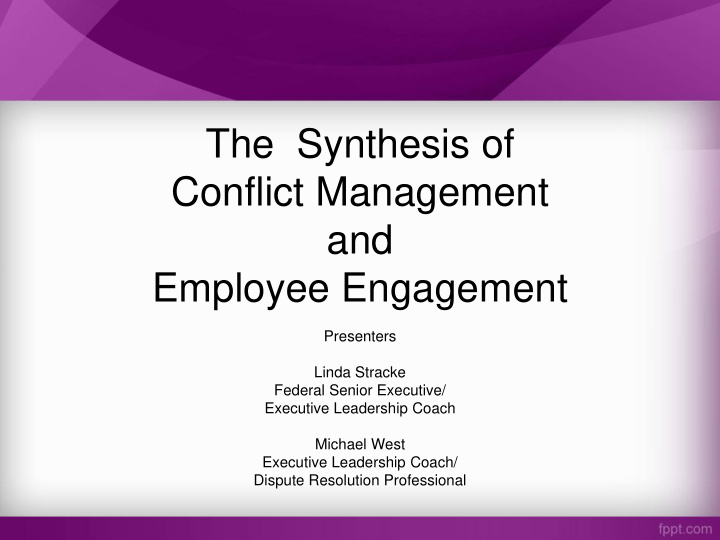



The Synthesis of Conflict Management and Employee Engagement Presenters Linda Stracke Federal Senior Executive/ Executive Leadership Coach Michael West Executive Leadership Coach/ Dispute Resolution Professional
Objectives Understand the concepts of conflict management and employee engagement Understand the neuroscience of employee engagement and conflict Explore how synthesizing conflict management and employee engagement can promote organizational effectiveness
Opposition v. Conflict does not OPPOSITION CONFLICT necessarily equal op’po•si’tion– n. 1. con•flict’– n. 1. A sharp Resistance, disagreement or collision contradiction, in interests, ideas and/or contrast, differences... principles... resulting in emotional disturbance... When a person’s sense Some of the most of self-worth is creative ideas come perceived to be from the synergy threatened or at risk. of opposition. Definitions from Webster’s New World Dictionary, Second College Edition
Conflict Management Conflict management Conflict prevention Conflict resolution Understand the concept of conflict preferences
Conflict Management The practice of recognizing and dealing with opposition (and/or conflict) in a rational, balanced and effective way. Conflict management implemented within a business environment usually involves effective communications, problem resolving abilities and good negotiating skills to restore the focus to the organization’s overall goals.
Conflict Prevention “any structural or intercessory means to keep tension and disputes from escalating, and to progressively reduce the underlying problems that produce these issues and disputes .”
Conflict Prevention Direct prevention – measures that are aimed at preventing short-term, often imminent, escalation of a potential conflict Structural prevention – focuses on long-term measures that address the underlying causes
Conflict Resolution Is it more than “mediation”? Conciliation Conflict Coaching Facilitation Facilitated dialogue __________________ __________________
Conflict Preferences Management Preferences Avoid Accommodate Collaborate Compete Compromise Thomas Kilmann
Employee Engagement OPM Definition “The employee’s sense of purpose that is evident in their display of dedication, persistence and effort in their work or overall attachment to their organization and mission.”
Employee Engagement The interplay among three factors: purpose trust, and discretionary effort and interest in the results Jan Hills, Founder, Head Heart + Brain
Neuroscience of Engagement The engaged brain The disengaged brain
Neuroscience of Engagement Relationship with the immediate supervisor is the strongest of all drivers of employee engagement
Neuroscience and Conflict Reasoned persuasion alone is seldom sufficient to convince a party in conflict of the logic of mediating. There is no initial neuro-chemical inducement to negotiate The first response of most people to a real or perceived threat is an emotional one, triggered neuro chemically in the brain, to either fight, flee the situation, or freeze.
“S.C.A.R.F.” Status Certainty Autonomy Relatedness Fairness
“ …in agencies where there are more employees filing complaints, there may not be the same level of engagement that is fostered in agencies where employees file fewer complaints.” Source: EEOC Complaint Data, Annual Report on the Federal Workforce Fiscal Year 2005
There is “a statistically significant negative correlation between the number of employees who file an EEO complaint in an agency and the agency’s average level of employee engagement.” The higher employee engagement score, the fewer number of employees file EEO complaints. Source: 2008 MSPB Report. The Power of Federal Employee Engagement
Commonly Heard “ I was denied training.” (Q: 47) “I don’t feel I am listened to and so I filed an EEO complaint.” (Q: 48) “It isn’t fair the way I was treated. I don’t know why I was treated this way. It must be because……” (Q: 49)
7 Levels of Effectiveness Synchronicity Innovation Engagement Courage Frustration Fear Hopelessness
Question? How often is “relationship” a part of the conflict?
7 Levels of Effectiveness Synchronicity Innovation Engagement Courage Frustration Fear Hopelessness
Leader Competencies Functional Technical Relational Emotional Conversational
Language relates to conversations and relationships .
The quality of language = quality of conversations = depth of relationships
Relationships provide the foundation for what can be achieved by an organization through its people.
Extraordinary results are created by creating extraordinary relationships.
What We Typically Do Assess or Create Implement the Desired diagnose the processes design Outcome current situation and Employee systems Engagement (and/or) Conflict Management
What Can We Do Instead Relationships Assess or Create Imple- Desired diagnose the processes ment the Outcome current and design Employee situation systems Engagement (and/or) Conflict Management The missing – essential component – to engaging the employee is: RELATIONSHIPS
What Are We Suggesting? Develop the soft skills with the hard skills. Know your yourself. Know your people. Increase the level of dialogue. BUILD THE RELATIONSHIPS!
What Are We Suggesting? Broaden the scope of conflict management and employee engagement to the relationship level. Create a holistic approach to conflict through the choice of more than one ADR option. Create a support system that links conflict management and employee engagement.
“ In organizations, real power and energy is generated through relationships. The patterns of relationships and the capacities to form them are more important than tasks, functions, roles, and positions." Margaret Wheatly, "Leadership and the New Science ””
Questions/Thoughts?
References Five Ways Neuroscience Can Improve Your Engagement Results. Jan Hills, Founder, Head Heart + Brain Language and the Pursuit of Leadership Excellence. Chalmers Brothers and Vinay Kumar Leadership and the New Science: Discovering Order in a Chaotic World. Third Edition. Margaret Wheatly Neuroscience of Engagement . David Rock The Seven Levels of Personal, Group and Organizational Effectiveness. BEabove Leadership. www.beaboveleadership.com 2008 MSPB Report. The Power of Federal Employee Engagement
Recommend
More recommend